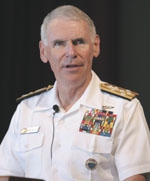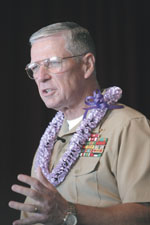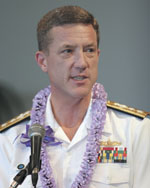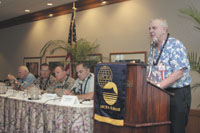Asia-Pacific Region Heats Up
 |
| Adm. William J. Fallon, USN, commander of the U.S. Pacific Command, gives the leadoff address at TechNet Asia-Pacific 2006. |
The Global War on Terrorism and the growth of network centricity are driving major shifts in military operations in the Asia-Pacific region. Growing and more sophisticated terrorist threats are placing greater emphasis on coalition operations among the dozens of countries that compose the vast arena. New networking technologies are changing the face of militaries throughout the region, but they also are taxing efforts to interoperate with diverse forces.
These were just a few of the points stressed at TechNet Asia-Pacific 2006, held November 6-9 in Honolulu, Hawaii. The 21st version of the annual event featured six key speakers and several panel discussions exploring the theme “Innovating and Accelerating Joint and Coalition Collaboration.”
It was fitting that the first breakfast speaker at the Asia-Pacific conference would be the commander of the U.S. Pacific Command. Adm. William J. Fallon, USN, told an overflow audience about the effect technology is having on his command as well as some of the political and military challenges it faces.
Adm. Fallon pulled few punches in describing some of the political issues. The
A key
Technology continues to transform the Pacific Command, the admiral related. Communications are faster, and the command has more data and more information. But, the command is often swamped or deluged by data, and it is hard to sort the wheat from the chaff, Adm. Fallon said. He warned against becoming mesmerized by technology and its capabilities.
A related challenge lies in ensuring coalition interoperability, which is critical across the dozens of nations in the Asia-Pacific region. While the command currently has good interoperability with many of its coalition partners,
The most critical issue of all of the command’s taskings remains turning information into knowledge that can be put to use, he maintained.
 |
| Rear Adm. Sally Brice-O’Hara, USCG, commander of the 14th Coast Guard District, describes the challenges facing her command and the Coast Guard as a whole in the Global War on Terrorism. |
Intelligence applied to maritime domain awareness is part of the Coast Guard’s efforts to push
Adm. Brice-O’Hara called intelligence an essential force multiplier for the Coast Guard’s limited resources and new missions. However, the admiral warned that the Coast Guard can get bogged down in too much information. She added that avoiding this pitfall will require filters for information relevance.
Existing command, control, communications, computers, intelligence, surveillance and reconnaissance (C4ISR) capabilities must be re-oriented and integrated with new sensors coming on line. In asking for its help, Adm. Brice-O’Hara urged that industry remember and consider the human-machine interface. Efforts are focusing on a user-defined operations picture.
Intelligence reform was the focus of one of the first panels, which was moderated by the Pacific Command J-2, Rear Adm. Andrew M. Singer, USN. Adm. Singer launched his panel by stating that the Global War on Terrorism will require conventional intelligence activities such as penetration of the enemy and analysis of information. Despite good technology advances, intelligence personnel “can’t just sit around with an antenna,” he warned.
The admiral said he does see “good direction” from post-9/11 reforms. While “the pieces are coming together,” he cited a sense of urgency in the need for intelligence sharing and usability and increased access. With terrorism, access to weapons of mass destruction and rogue states posing global threats, “there is a lot of bad stuff out there,” he emphasized, so the intelligence community must outthink its adversaries.
Before 9/11, the Federal Bureau of Investigation (FBI) was not always good at intelligence analysis and sharing, offered the special agent in charge of its
The bureau is undergoing significant cultural changes to carry out its mission in the Global War on Terrorism. The FBI’s new Directorate of Intelligence has a threat-driven focus instead of the previous case-driven approach, Goodwin explained. And, the FBI is moving from being solely an intelligence community contributor to being a full partner in the community. The goal is for the bureau to go beyond being just crimefighters to being the nation’s premier domestic intelligence agency, he declared.
Accomplishing effective military intelligence exploitation will require a joint approach, said Capt. William Klauberg, USN, J-2, Inter-Agency Task Force West. Echoing Adm. Singer’s comments, Capt. Klauberg noted that much has been done since 9/11, but intelligence still has a long way to go. Among the recommendations of the 9/11 report that remain to be attained are unity of effort and unity in information sharing.
The captain cited several interconnected threats that challenge the intelligence community. While criminals conduct their enterprises for profit, that money can fund terrorist activities. For example, the Spanish rail bombers used Moroccan drug money to buy their explosives. And, document counterfeiting has generated a surge in phony passports, particularly in visa-waiver countries. Since the captain’s organization moved its headquarters from
From the Air Force’s perspective, intelligence increasingly is global in both source and customer. Col. Martin Neubauer, USAF, A-2, Pacific Air Forces, emphasized the importance of processing intelligence data instead of measuring success by front-end elements. No front end will work, he said, without effective information fusion and dissemination. “Disparate streams of data should not be allowed to float out there by themselves,” he stated.
The colonel noted that intelligence is much more democratic than before. Many more young, lower ranking people are taking part in it. However, the cost of that democratization is a loss of control, and some people do not like that. Technology is aiding the intelligence transformation, especially with its global reach. “Never move a molecule when an electron will do,” he remarked.
 |
| Discussing how to simplify interoperability among partners are panelists (l-r) Robert A. Stephenson, chief technology officer for C4ISR Operations at the Pacific Fleet; Col. Darryl Dean, USA, commander, Defense Information Systems Agency Pacific; Maj. Gen. (P) Randolph Strong, USA, commanding general, U.S. Army Signal Center and Fort Gordon; Brig. Gen. Frank J. Kisner, USAF, deputy director, strategic planning and policy, U.S. Pacific Command; and moderator Brig. Gen. (P) Jennifer Napper, USA, U.S. Pacific Command J-6. |
Brig. Gen. Frank J. Kisner, USAF, deputy director, strategic planning and policy, U.S. Pacific Command, offered that low-end solutions are just as important as high-end solutions—and probably just as difficult to achieve. A major challenge is to bring advanced information technology down to levels that have not had it yet. Many nations do not have the ability to integrate communications, he warned.
Maj. Gen. (P) Randolph Strong,
However, training is the key to network success, Gen. Strong emphasized. The
Navy command and control (C2) has been revolutionized by chat capabilities, offered Robert A. Stephenson, chief technology officer for C4ISR Operations at the Pacific Fleet. Nation-to-nation connectivity is a chat goal, he said, citing how
 |
| Lt. Gen. John F. Goodman, USMC, commander of Marine Forces Pacific, tells a breakfast audience how interoperability will be crucial as the Global War on Terrorism grows and other trouble spots threaten to heat up. |
Gen. Goodman discussed several other regional challenges facing the Marine Corps. He does not believe that conventional war with
“I don’t have to make decisions faster than the Russian or Chinese army … I have to make decisions faster than the enemy I’m facing,” he stated.
The Marine general asked industry to develop a C2 system that will allow him to request the information that he needs and display it in a form that he wants. Too much information today is text based, and this new form should be seamless, simple and meaningful and provide a graphical presentation of an idea. Cartoons, for example, are intuitive and should be considered, he said.
 |
| The commander of Pacific Air Forces, Gen. Paul V. Hester, USAF, emphasizes the importance of communications across the vast Asia-Pacific region. |
Gen. Hester described the new air operations center (AOC) being installed at Hickham Air Force Base in
The general continued that Pacific Air Forces must be able to assess its data and present it in a timely manner that makes it useful. The command has invited Asia-Pacific allies to visit the new AOC to encourage their involvement. This hoped-for involvement will require multiple levels of layered security, he added.
“[North Korean leader] Kim Jong-Il brought us closer,” the captain declared.
Among the new steps taken by the longtime allies were daily intelligence operations videoconferencing, a bilateral pro-active public affairs strategy and the deployment of a Japan Aegis destroyer that fed its radar data into the
Col. Vince Valdespino, USAF, chief information officer (CIO)/A-6, Pacific Air Forces, noted that the Asia-Pacific region comprises more than 1,000 languages and dialects. It is vital to merge and collapse databases and reduce the number of networks to ease information sharing, he said. The Air Force is taking those types of steps to consolidate functions for the region.
 |
| Rear Adm. Dirk J. Debbink, USNR, Reserve deputy and chief of staff for the U.S. Pacific Fleet, tells the audience of the final luncheon how the fleet needs a single interoperable information system. |
The Rim of the Pacific (RIMPAC) 2006 exercise (SIGNAL Magazine, November 2006) allowed multiple countries to share a single common operational picture. The Cooperative Maritime Forces Pacific network (CMFP) was a defining success of RIMPAC, the admiral stated, and commercial off-the-shelf technologies were key to making the system standard and affordable.
He continued that the fleet needs a single interoperable information system that can work in an afloat environment with limited bandwidth. The Navy also is looking for a cost-effective data transport. Systems such as CMFP and maritime domain awareness are the right steps in the right direction, but much more remains to be done, the admiral declared.
 |
| Lt. Gen. John M. Brown III, USA, commanding general of the U.S. Army Pacific, outlines his command’s priorities to address both Army and Pacific Command needs. |
The general listed four priorities for his command. First is the Global War on Terrorism, with more than half of the 43 nations in the Asia-Pacific region facing some sort of insurgency. Most of these insurgencies are Muslim based, the general noted, particularly the one in the
The second priority is the Theater Security Cooperation Program. Five of the seven
The third priority is to support PACOM transformation. The Army’s modular transformation program has led to significant changes in the U.S. Army Pacific (SIGNAL Magazine, November 2006). The fourth priority is quality of service. Gen. Brown’s command is building 100 family housing units a month under commercial contracts, and online education has been brought to a new level. Re-enlistment is on track, he reported, citing that more than 300 paratroopers re-enlisted when they arrived in theater.
 |
| Support to the warfighter was the focus of the show’s final panel. Discussing that topic are (r-l) panel moderator Maj. Gen. Eugene C. Renzi, USA (Ret.), president, ManTech Defense Systems Group; Lt. Gen. Steven W. Boutelle, USA, Army G-6/chief information officer; Maj. Gen. David P. Fridovich, USA, commander, Special Operations Command, Pacific; Jim Craft, U.S. Marine Corps’ deputy director for C4; and Maj. Gen. Robert H. Scales, USA (Ret.), co-author of The Iraq War. |
The transition to everything over IP is going smoothly with fixed facilities, but it is tougher for the warfighter, the general observed. The Army is a full IP-based community as it deploys into
The Army wants the best, most efficient, lightest equipment that uses the least amount of power and offers the best environmental quality for the warfighter, Gen. Boutelle continued. To achieve interoperability, the Army needs standards for both data and applications. Also, someone must determine just who is the authoritative data source. Often the senior individual prevails instead of the source who is correct, he said.
The Marines are partnering with the Army to an ever-increasing degree, said the Corps’ deputy director for C4. Jim Craft told the audience that this partnership is giving the Marines more bang for their buck as the Corps re-shapes itself to be an intellectually empowered joint force.
The Marines are looking to partner with the private sector for equipment that must be extremely tough and secure, he continued. Commercial technologies are proving their worth in
Special operations forces are upgrading their gear to suit their new missions, explained Maj. Gen. David P. Fridovich,
Gen. Fridovich noted that
But efforts to win the Global War on Terrorism cannot depend on technology, said Maj. Gen. Robert H. Scales,
The war’s center of gravity is at the tactical level, and there is a problem connecting communications technology with the reality of the battlefield at the tactical level, he continued. The
Photography by William R. Goodwin.
Web Resource
TechNet Asia-Pacific 2006 Panel Presentations: www.afcea.org/events/pastevents/default.htm




Comments